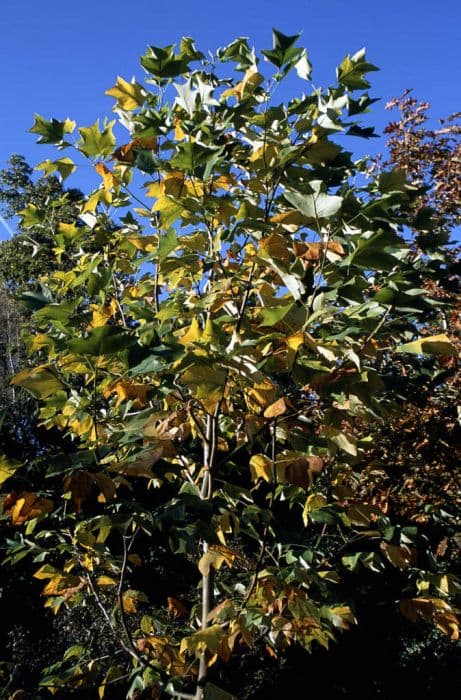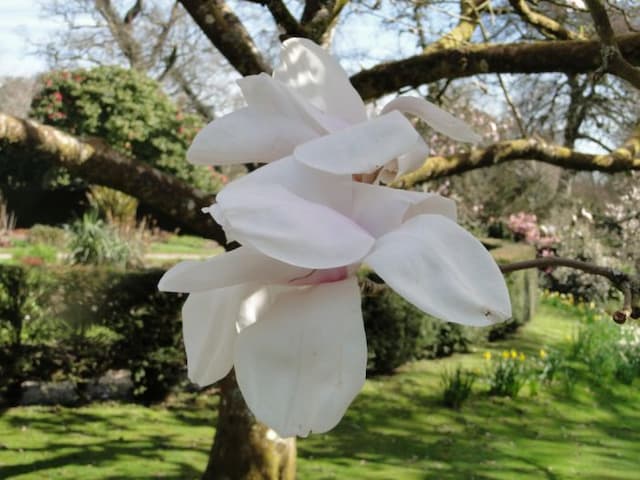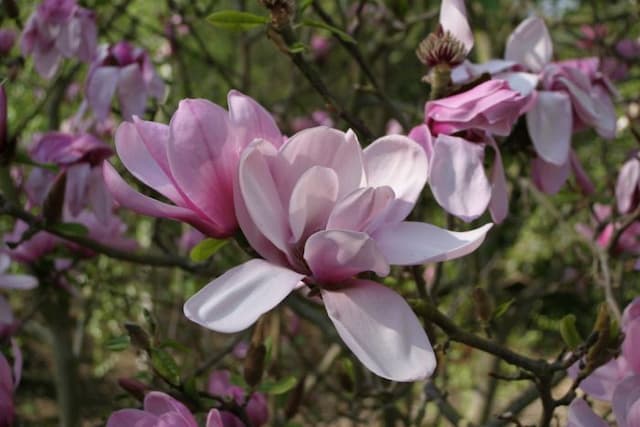Star magnolia 'King Rose' Magnolia stellata 'King Rose'

ABOUT
'King Rose' is a slow-growing, medium-sized, deciduous shrub of broadly-rounded shape, with narrow oval leaves. Lightly-scented flowers, produced in early spring before the leaves, have up to 30 narrow petals and are pale pink in bud, with some darker flushing, fading to white once open
About this plant
 Names
NamesFamily
Magnoliaceae
Synonyms
Star Magnolia, Starry Magnolia
Common names
Magnolia kobus var. stellata, Magnolia stellata 'Rosea'
 Characteristics
CharacteristicsLife cycle
Perennials
Foliage type
Deciduous
Color of leaves
Green
Flower color
Pink
Height
15 feet (4.57 meters)
Spread
10 feet (3.05 meters)
Plant type
Shrub
Hardiness zones
4-8
Native area
Japan
Benefits
 General Benefits
General Benefits- Aesthetic Appeal: Star Magnolia 'King Rose' is admired for its large, rose-pink blooms that enhance any landscape with visual beauty.
- Seasonal Interest: It flowers in early spring, providing an early burst of colour after the winter season.
- Wildlife Attraction: The blossoms provide nectar for pollinators such as bees and butterflies, promoting biodiversity.
- Compact Size: The shrub's smaller stature makes it suitable for smaller gardens or limited spaces.
- Low Maintenance: Once established, it requires minimal care beyond occasional pruning and watering.
- Scent: The fragrant flowers can add a pleasant aroma to gardens and outdoor living spaces.
- Year-round Interest: Along with spring blossoms, it offers interesting seed pods in summer and fall, as well as a pleasing branch structure in winter.
- Tolerance: It demonstrates a good tolerance to a range of soil types, provided they are well-drained.
- Adaptability: Star Magnolia 'King Rose' can adapt to a variety of climate conditions within its hardiness zones.
- Urban Suitable: It's relatively tolerant to pollution, making it suitable for urban and suburban environments.
 Medical Properties
Medical PropertiesThis plant is not used for medical purposes.
 Air-purifying Qualities
Air-purifying QualitiesThis plant is not specifically known for air purifying qualities.
 Other Uses
Other Uses- Photography Subject: The Magnolia stellata's beautiful blossoms make it a popular choice for garden photography, providing a stunning subject for both professionals and hobbyists.
- Artistic Inspiration: Artists may use the intricate patterns of the 'King Rose' magnolia's flowers as inspiration for paintings, drawings, and other forms of artwork.
- Wedding Decor: Branches of Magnolia stellata can be used in wedding arrangements or as a natural element in bridal bouquets for their delicate appearance and fragrance.
- Fabric Dyeing: The petals of the 'King Rose' can be used to create natural dyes for fabrics, offering a range of soft, muted colors.
- Culinary Garnish: Though not commonly consumed, the petals of the Magnolia stellata can be used as a delicate, edible garnish for desserts and special dishes.
- Floral Crafts: The sturdy structure of the flowers makes them suitable for crafting dried flower arrangements or potpourri.
- Educational Tool: The plant can be used in school projects or educational gardens to teach botany and plant reproduction.
- Perfume Production: Some perfumers may use the essence of 'King Rose' magnolias as a component in fragrances, due to its subtle and appealing scent.
- Religious Ceremonies: In some cultures, the blossoms may be used in religious ceremonies as a symbol of purity or beauty.
- Signature Landscape Element: Magnolia stellata can serve as a distinctive feature in landscape design, providing a focal point in gardens and parks.
Interesting Facts
 Feng Shui
Feng ShuiThe Star Magnolia is not used in Feng Shui practice.
 Zodiac Sign Compitability
Zodiac Sign CompitabilityThe Star Magnolia is not used in astrology practice.
 Plant Symbolism
Plant Symbolism- Perseverance and durability: Magnolia trees are known for their tough, hardy nature, representing an individual's ability to stand strong through hardship.
- Nobility and dignity: The regal appearance and often large and imposing stature of magnolias are symbolic of a noble spirit or a dignified personality.
- Femininity and beauty: With its delicate and showy flowers, the magnolia is often associated with the softness, beauty, and grace of femininity.
- Purity and innocence: The color of the Magnolia stellata 'King Rose', primarily white, traditionally symbolizes purity and innocence.
- Love for nature: As magnolias are ancient plants and are often seen in natural, undisturbed habitats, they can symbolize a love and appreciation for the natural world.
 Water
WaterThe Star Magnolia should be watered deeply to saturate the root zone, and then allowed to dry out slightly before the next watering. During the growing season, this would generally be about once a week, depending on climate and soil conditions, providing approximately 1-2 gallons per watering for young plants, and more for established trees. It's essential to avoid overwatering, as this can lead to root rot. Always check the soil moisture level a few inches below the surface; if it's dry, it's time to water.
 Light
LightThe Star Magnolia thrives in full sun to partial shade. Ideally, plant it in a location where it will receive at least four hours of direct sunlight each day. However, in extremely hot climates, afternoon shade can help protect the plant from intense heat.
 Temperature
TemperatureThe Star Magnolia can tolerate a broad range of temperatures, but it performs best in areas where the temperature typically ranges between 40°F and 80°F. It can survive minimum temperatures down to about -20°F once established. Ideal growing temperatures are within the moderate zone, avoiding extreme heat or frost.
 Pruning
PruningThe Star Magnolia benefits from pruning to shape the tree, remove any dead or crossed branches, and promote healthy growth. Prune after flowering, generally in late spring or early summer, to avoid cutting off next year's buds. Pruning every 2 to 3 years is usually adequate.
 Cleaning
CleaningAs needed
 Soil
SoilThe Star Magnolia prefers well-drained, slightly acidic soil with a pH of 5.5 to 6.5. A mix of loamy soil with added peat moss and compost provides ideal conditions for growth and blooming.
 Repotting
RepottingStar Magnolia trees, being slow growers, typically do not need frequent repotting. Young trees can be repotted every 2 to 3 years, while mature specimens may only need repotting every 5 years or when pot-bound.
 Humidity & Misting
Humidity & MistingThe Star Magnolia thrives in average humidity levels. As long as the plant is outdoors, it generally does not require any special humidity considerations.
 Suitable locations
Suitable locationsIndoor
Ensure bright light, cool temps, and water when topsoil is dry.
Outdoor
Plant in moist, well-drained soil with partial to full sun.
Hardiness zone
4-8 USDA
 Life cycle
Life cycleStar Magnolia 'King Rose' begins its life as a seed, which requires stratification to break dormancy and germinate. Once germinated, the seedling emerges and grows into a young plant, developing a root system and foliage. As the plant matures, it enters a vegetative state, characterized by the growth of leaves and the establishment of a sturdy stem structure. The next stage is the flowering phase, where 'King Rose' produces showy, fragrant, rose-pink flowers in early spring before the leaves fully unfold. After pollination, typically by bees and other insects attracted to the flowers, the plant forms fruit which is a cone-like aggregate of follicles containing the seeds. Finally, as the seasons change, the star magnolia enters a period of dormancy during the winter months, conserving energy in preparation for the next growth cycle.
 Propogation
PropogationPropogation time
Spring
The most popular method of propagating the Star Magnolia is through softwood cuttings taken in late spring or early summer. To do this, a gardener would select a healthy, non-flowering shoot and cut a 4 to 6-inch (10 to 15 cm) section, making sure there are at least two to three sets of leaves. The bottom leaves are removed, and the cut end is dipped into rooting hormone to promote root development. This cutting is then placed in a potting mix with good drainage and kept moist under high humidity and indirect light. It can take several weeks for roots to develop, after which it can be gradually acclimated to normal growing conditions before transplanting it into the garden.









![Magnolia [Felix Jury]](/_next/image?url=https%3A%2F%2Fplants-admin.emdemapps.com%2Fimages%2Fplants%2F%2Fimages%2F604b61a0b23b7.png&w=640&q=75)